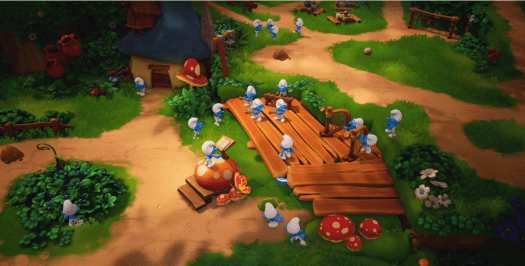It seemed like the perfect gaming idea – take the hugely popular Nintendo Game Boy and enable gamers to combine its games with the also-hugely popular Super Nintendo Entertainment System. Antstream Arcade digs into the archives to unearth the history of Nintendo’s Super Game Boy peripheral in the second of our retro gaming history features. In case you missed it, our first Antstream Arcade Retro Gaming History focused on retro gaming in Brazil.
In 1994, Nintendo was still bossing the games scene. Its latest console, the Super Nintendo Entertainment System, or SNES, remained popular, as did the Game Boy, the cheap and efficient handheld that enabled gamers to play classics such as Tetris and Super Mario Land on the fly. Yet one thing the Game Boy didn’t have was a variety of colours: every one of its marvellously playable games appeared in a murky and blurred green. With the Game Boy Color four years away, Nintendo had to try something different if it was to bring the rainbow to the handheld’s incredible library of games.
So What Does It Do?
Simply put, by plugging the Super Game Boy device into your SNES console, you instantly had potential access to the handheld’s vast library of titles. However, Nintendo knew this wouldn’t be enough, so a few more tricks were up the Super Game Boy’s sleeve. Firstly, the device added border effects, nine built-in surrounds and the ability to create custom borders (sadly, unsavable). The built-in borders included an Escher-type arrangement of blocks, a cork board and a bucolic meadow.
Secondly, the Game Boy’s games got a much-needed splash of colour. The Super Game Boy featured 32 in-built colour palettes, adding variety to each one and able to alter the colour throughout the game, while some games (mainly beat-‘em-ups such as Killer Instinct) permitted the use of the second SNES controller. Finally, developers could enhance a game’s audio, using the host SNES unit to play 16-bit sound.
A Land In Colour
With the player able to choose different palette hues for their Game Boy games, fans could now play their favourite games in a pre-chosen colour. You could even devise your own colours, mixing the four shades to create a bespoke hue – but it was necessary to keep a pen handy for noting down the resultant passcode, the lack of a save battery continuing to prove a drawback to player’s creative endeavours.
The Super Game Boy was released in the summer of 1994, retailing for £49.99 in the UK. While easy to use and an excellent peripheral for anyone wishing to play their Game Boy games on the big screen, its extra tricks relied on the support of developers. The device is effectively a Game Boy, which owners can plug directly into the SNES’s cartridge slot. As a result, all original Game Boy games were compatible; unfortunately, few developers took advantage of the Super Game Boy’s capabilities.
A Place In History
While far from a best-seller, the Super Game Boy was enough of a success in Japan to inspire a follow-up, the Super Game Boy 2 and a bespoke controller, the Super Game Boy Commander. Both were Japanese exclusives and no doubt inspired by the breakout phenomenon of the Pokémon franchise: it included a link cable port, enabling fans to battle away on the Game Boy versions of their favourite Pokémon game.
Furthermore, Nintendo persevered with the concept, an in-house studio devising the Wide Boy (Game Boy games on a Nintendo Entertainment System) and Wide Boy 64 (on the Nintendo 64), although these were not available to the public. Finally, there was the Game Boy Player for the Nintendo GameCube. This device housed Game Boy Advance technology, that handheld’s backward compatibility enabling the use of original Game Boy and Game Boy Color cartridges, in addition, of course, to Game Boy Advance Games.
The Best Games For The Super Game Boy Experience
Few developers used the Super Game Boy’s extra abilities – and in any case, with cartridge space at a premium, it often wasn’t even possible. Marked initially with ‘Super Game Boy Game Pak’, there are four of our favourite games that did make an effort to create something markedly different.
Space Invaders
The SGB-enhanced Space Invaders is a one-of-a-kind game – or rather, games! Inside its cartridge sits an SBA version of the original Game Boy conversion of the arcade classic, complete with a border that mimics the arcade game. There are further colour options for this mode; however, the inclusion of an actual SNES game, a faithful port of the arcade game, complete with various gameplay options, is a massive bonus for Super Game Boy owners.
Wario Land II
This Game Boy sequel uses different borders for each level, and while sometimes distracting, they’re all lovingly detailed, especially the castle border of the early levels. In each one, the porcine Wario gazes down from the upper edge.
A Bug’s Life
Early Game Boy Color games were often merely upgraded original Game Boy releases, conveniently making them compatible with the Super Game Boy. This Game Boy Color game from 1998 boasts an SGB-enhanced version, sporting an incredible SNES-style soundtrack, which adds another dimension to its insectoid antics.
Donkey Kong
Game Boy Donkey Kong is a relatively accurate port of the arcade game, and its origins are lovingly demonstrated in the coin-op-inspired border. There are also improved colours and sound, making this the best way to experience DK on the Game Boy.
Did you have a Super Game Boy back in the nineties? What were your favourite games to play?
We’ll see you next week with more great titles to play anytime, anywhere on Antstream
The post Antstream Arcade Retro Gaming History II: The Super Game Boy appeared first on Old School Gamer Magazine.


